16.ff - 2307 Windsor Rd #2 - public comment — original pdf
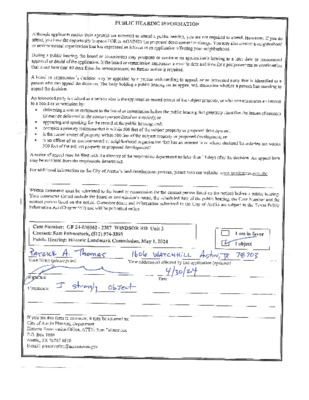
Backup

Backup
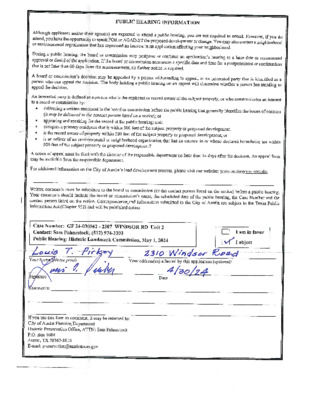
Backup
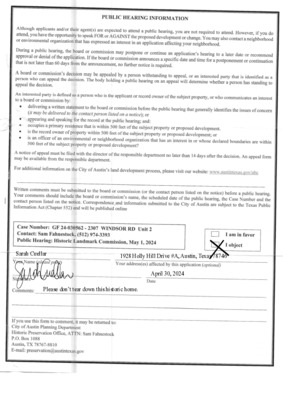
Backup
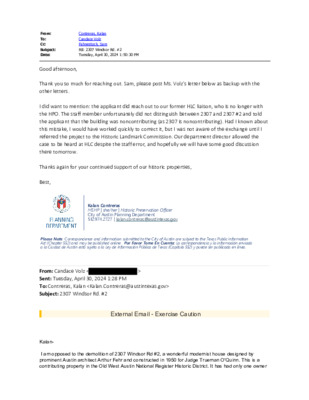
From: To: Cc: Subject: Date: Contreras, Kalan Candace Volz Fahnestock, Sam RE: 2307 Windsor Rd. #2 Tuesday, April 30, 2024 1:50:30 PM Good afternoon, Thank you so much for reaching out. Sam, please post Ms. Volz’s letter below as backup with the other letters. I did want to mention: the applicant did reach out to our former HLC liaison, who is no longer with the HPO. The staff member unfortunately did not distinguish between 2307 and 2307 #2 and told the applicant that the building was noncontributing (as 2307 is noncontributing). Had I known about this mistake, I would have worked quickly to correct it, but I was not aware of the exchange until I referred the project to the Historic Landmark Commission. Our department director allowed the case to be heard at HLC despite the staff error, and hopefully we will have some good discussion there tomorrow. Thanks again for your continued support of our historic properties, Best, Kalan Contreras MSHP | she/her | Historic Preservation Officer City of Austin Planning Department 512.974.2727 | kalan.contreras@austintexas.gov Please Note: Correspondence and information submitted to the City of Austin are subject to the Texas Public Information Act (Chapter 552) and may be published online. Por Favor Tome En Cuenta: La correspondencia y la información enviada a la Ciudad de Austin está sujeta a la Ley de Información Pública de Texas (Capítulo 552) y puede ser publicada en línea. From: Candace Volz < Sent: Tuesday, April 30, 2024 1:28 PM To: Contreras, Kalan <Kalan.Contreras@austintexas.gov> Subject: 2307 Windsor Rd. #2 > External Email - Exercise Caution Kalan- I am opposed to the demolition of 2307 Windsor Rd #2, a wonderful modernist house designed by prominent Austin architect Arthur Fehr and constructed in 1950 for Judge Trueman O'Quinn. This is a contributing property in the Old West Austin National Register Historic District. It has had only one owner family and is in near original condition. Yes it needs updating, which would not be not difficult, and it will continue to be an asset to our NRD and to Austin. The last thing any of us needs is another oversized, characterless new house in this historic old neighborhood. The developer who proposes to tear this contributing house down says that he was aware of the OWANRD, but could not find any information online. As one of the creators of this NRD twenty years ago (it is …
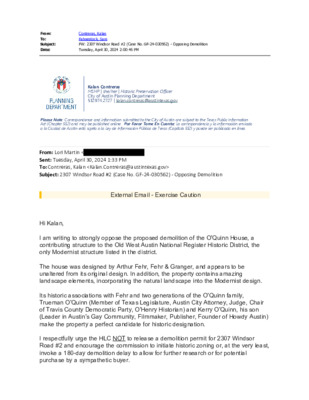
Contreras, Kalan Fahnestock, Sam FW: 2307 Windsor Road #2 (Case No. GF-24-030562) - Opposing Demolition Tuesday, April 30, 2024 2:00:46 PM From: To: Subject: Date: Kalan Contreras MSHP | she/her | Historic Preservation Officer City of Austin Planning Department 512.974.2727 | kalan.contreras@austintexas.gov Please Note: Correspondence and information submitted to the City of Austin are subject to the Texas Public Information Act (Chapter 552) and may be published online. Por Favor Tome En Cuenta: La correspondencia y la información enviada a la Ciudad de Austin está sujeta a la Ley de Información Pública de Texas (Capítulo 552) y puede ser publicada en línea. From: Lori Martin < Sent: Tuesday, April 30, 2024 1:33 PM To: Contreras, Kalan <Kalan.Contreras@austintexas.gov> Subject: 2307 Windsor Road #2 (Case No. GF-24-030562) - Opposing Demolition External Email - Exercise Caution Hi Kalan, I am writing to strongly oppose the proposed demolition of the O'Quinn House, a contributing structure to the Old West Austin National Register Historic District, the only Modernist structure listed in the district. The house was designed by Arthur Fehr, Fehr & Granger, and appears to be unaltered from its original design. In addition, the property contains amazing landscape elements, incorporating the natural landscape into the Modernist design. Its historic associations with Fehr and two generations of the O'Quinn family, Trueman O'Quinn (Member of Texas Legislature, Austin City Attorney, Judge, Chair of Travis County Democratic Party, O'Henry Historian) and Kerry O'Quinn, his son (Leader in Austin's Gay Community, Filmmaker, Publisher, Founder of Howdy Austin) make the property a perfect candidate for historic designation. I respectfully urge the HLC NOT to release a demolition permit for 2307 Windsor Road #2 and encourage the commission to initiate historic zoning or, at the very least, invoke a 180-day demolition delay to allow for further research or for potential purchase by a sympathetic buyer. Sincerely, Lori Martin Lori Martin, MSHP Architectural Historian O’Connell Architecture, LLC 3908 Avenue B, #309 • Austin • Texas • 78751 • 512.423.6841 CAUTION: This is an EXTERNAL email. Please use caution when clicking links or opening attachments. If you believe this to be a malicious or phishing email, please report it using the "Report Message" button in Outlook. For any additional questions or concerns, contact CSIRT "cybersecurity@austintexas.gov."
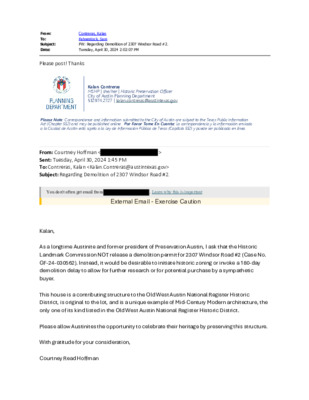
From: To: Subject: Date: Contreras, Kalan Fahnestock, Sam FW: Regarding Demolition of 2307 Windsor Road #2. Tuesday, April 30, 2024 2:02:07 PM Please post! Thanks Kalan Contreras MSHP | she/her | Historic Preservation Officer City of Austin Planning Department 512.974.2727 | kalan.contreras@austintexas.gov Please Note: Correspondence and information submitted to the City of Austin are subject to the Texas Public Information Act (Chapter 552) and may be published online. Por Favor Tome En Cuenta: La correspondencia y la información enviada a la Ciudad de Austin está sujeta a la Ley de Información Pública de Texas (Capítulo 552) y puede ser publicada en línea. From: Courtney Hoffman < Sent: Tuesday, April 30, 2024 1:45 PM To: Contreras, Kalan <Kalan.Contreras@austintexas.gov> Subject: Regarding Demolition of 2307 Windsor Road #2. > You don't often get email from . Learn why this is important External Email - Exercise Caution Kalan, As a longtime Austinite and former president of Preservation Austin, I ask that the Historic Landmark Commission NOT release a demolition permit for 2307 Windsor Road #2 (Case No. GF-24-030562). Instead, it would be desirable to initiate historic zoning or invoke a 180-day demolition delay to allow for further research or for potential purchase by a sympathetic buyer. This house is a contributing structure to the Old West Austin National Register Historic District, is original to the lot, and is a unique example of Mid-Century Modern architecture, the only one of its kind listed in the Old West Austin National Register Historic District. Please allow Austinites the opportunity to celebrate their heritage by preserving this structure. With gratitude for your consideration, Courtney Read Hoffman CAUTION: This is an EXTERNAL email. Please use caution when clicking links or opening attachments. If you believe this to be a malicious or phishing email, please report it using the "Report Message" button in Outlook. For any additional questions or concerns, contact CSIRT "cybersecurity@austintexas.gov."
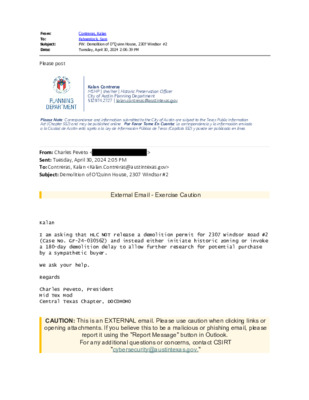
Contreras, Kalan Fahnestock, Sam FW: Demolition of O"Quinn House, 2307 Windsor #2 Tuesday, April 30, 2024 2:06:39 PM From: To: Subject: Date: Please post Kalan Contreras MSHP | she/her | Historic Preservation Officer City of Austin Planning Department 512.974.2727 | kalan.contreras@austintexas.gov Please Note: Correspondence and information submitted to the City of Austin are subject to the Texas Public Information Act (Chapter 552) and may be published online. Por Favor Tome En Cuenta: La correspondencia y la información enviada a la Ciudad de Austin está sujeta a la Ley de Información Pública de Texas (Capítulo 552) y puede ser publicada en línea. From: Charles Peveto < Sent: Tuesday, April 30, 2024 2:05 PM To: Contreras, Kalan <Kalan.Contreras@austintexas.gov> Subject: Demolition of O'Quinn House, 2307 Windsor #2 > External Email - Exercise Caution Kalan I am asking that HLC NOT release a demolition permit for 2307 Windsor Road #2 (Case No. GF-24-030562) and instead either initiate historic zoning or invoke a 180-day demolition delay to allow further research for potential purchase by a sympathetic buyer. We ask your help. Regards Charles Peveto, President Mid Tex Mod Central Texas Chapter, DOCOMOMO CAUTION: This is an EXTERNAL email. Please use caution when clicking links or opening attachments. If you believe this to be a malicious or phishing email, please report it using the "Report Message" button in Outlook. For any additional questions or concerns, contact CSIRT "cybersecurity@austintexas.gov."
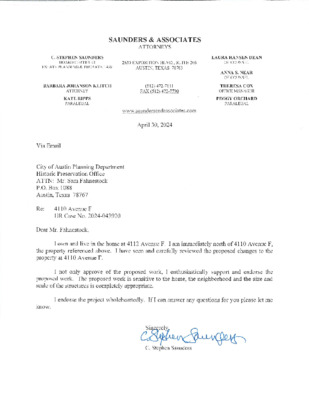
Backup
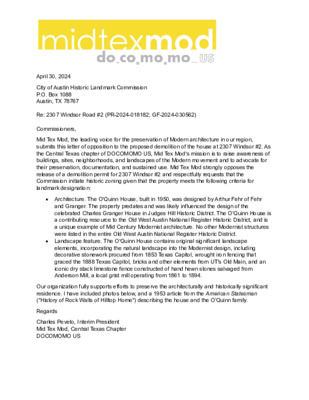
April 30, 2024 City of Austin Historic Landmark Commission P.O. Box 1088 Austin, TX 78767 Re: 2307 Windsor Road #2 (PR-2024-018182; GF-2024-030562) Commissioners, Mid Tex Mod, the leading voice for the preservation of Modern architecture in our region, submits this letter of opposition to the proposed demolition of the house at 2307 Windsor #2. As the Central Texas chapter of DOCOMOMO US, Mid Tex Mod's mission is to raise awareness of buildings, sites, neighborhoods, and landscapes of the Modern movement and to advocate for their preservation, documentation, and sustained use. Mid Tex Mod strongly opposes the release of a demolition permit for 2307 Windsor #2 and respectfully requests that the Commission initiate historic zoning given that the property meets the following criteria for landmark designation: • Architecture. The O'Quinn House, built in 1950, was designed by Arthur Fehr of Fehr and Granger. The property predates and was likely influenced the design of the celebrated Charles Granger House in Judges Hill Historic District. The O'Quinn House is a contributing resource to the Old West Austin National Register Historic District, and is a unique example of Mid Century Modernist architecture. No other Modernist structures were listed in the entire Old West Austin National Register Historic District. • Landscape feature. The O'Quinn House contains original significant landscape elements, incorporating the natural landscape into the Modernist design, including decorative stonework procured from 1853 Texas Capitol, wrought iron fencing that graced the 1888 Texas Capitol, bricks and other elements from UT's Old Main, and an iconic dry stack limestone fence constructed of hand hewn stones salvaged from Anderson Mill, a local grist mill operating from 1861 to 1894. Our organization fully supports efforts to preserve the architecturally and historically significant residence. I have included photos below, and a 1953 article from the American Statesman ("History of Rock Walls of Hilltop Home") describing the house and the O'Quinn family. Regards Charles Peveto, Interim President Mid Tex Mod, Central Texas Chapter DOCOMOMO US

From: To: Cc: Subject: Date: Contreras, Kalan John Volz Fahnestock, Sam RE: O"Quinn House (Case No. GR-24-030562 Tuesday, April 30, 2024 3:26:30 PM Thanks so much for reaching out. Sam, please post as backup—thank you! Kalan Contreras MSHP | she/her | Historic Preservation Officer City of Austin Planning Department 512.974.2727 | kalan.contreras@austintexas.gov Please Note: Correspondence and information submitted to the City of Austin are subject to the Texas Public Information Act (Chapter 552) and may be published online. Por Favor Tome En Cuenta: La correspondencia y la información enviada a la Ciudad de Austin está sujeta a la Ley de Información Pública de Texas (Capítulo 552) y puede ser publicada en línea. com> From: John Volz Sent: Tuesday, April 30, 2024 3:25 PM To: Contreras, Kalan <Kalan.Contreras@austintexas.gov> Subject: O'Quinn House (Case No. GR-24-030562 You don't often get email from . Learn why this is important External Email - Exercise Caution Dear Kalan, I am writing to ask that the HLC NOT release a demolition permit for 2307 Windsor Road #2 (Case No. GF-24-030562) and either initiate historic zoning or invoke a 180-day demolition delay to allow for further research and potential purchase by a sympathetic buyer. Given the house’s contributing status in the Old West Austin National Register Historic District, its unique Mid Century Modernist architecture, its architect, its original condition and integrity, its association with two generations of the O’Quinn family, their contributions to Austin and the state, and unique landscape features, I think that it should be an Austin Landmark. Sincerely, John John Volz, AIA Volz & Associates, Inc. / 1406 Preston Avenue, Austin, Texas 78703 / 512-476- 0433 / This e-mail (including attachments) is covered by the Electronic Communications Privacy Act, 18 U.S.C. Secs. 2510-2521 and contains PRIVILEGED AND CONFIDENTIAL INFORMATION intended only for the use of the recipient(s) named above. If you are not the intended recipient of this e-mail, or the employee or agent responsible for delivering it to the intended recipient, you are hereby notified that any retention, dissemination, distribution or copying of this e-mail is strictly prohibited. If you have received this e-mail in error, please immediately notify us via e-mail and delete this e-mail from your system. Thank you. CAUTION: This is an EXTERNAL email. Please use caution when clicking links or opening attachments. If you believe this to be a malicious or phishing email, please report it using the "Report Message" …
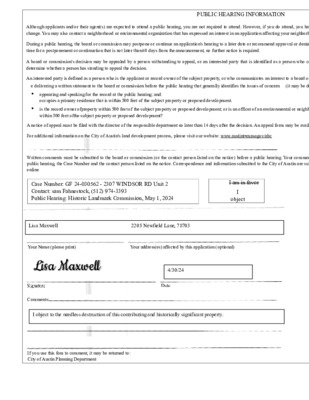
PUBLIC HEARING INFORMATION Although applicants and/or their agent(s) are expected to attend a public hearing, you are not required to attend. However, if you do attend, you have the opportunity to speak FOR or AGAINST the proposed development or change. You may also contact a neighborhood or environmental organization that has expressed an interest in an application affecting your neighborhood. During a public hearing, the board or commission may postpone or continue an application's hearing to a later date or recommend approval or denial ofthe application. If the board or commission announces a specific date and time for a postponement or continuation that is not later than 60 days from the announcement, no further notice is required. A board or commission's decision may be appealed by a person withstanding to appeal, or an interested party that is identified as a person who can appeal the decision. The body holding a public hearing on an appeal will determine whether a person has standing to appeal the decision. An interested party is defined as a person who is the applicant or record owner of the subject property, or who communicates an interest to a board or commission by: e delivering a written statement to the board or commission before the public hearing that generally identifies the issues of concern (it may be delivered to the contact person listed on a notice); or • appearing and speaking for the record at the public hearing; and: occupies a primary residence that is within 500 feet of the subject property or proposed development. • is the record owner ofproperty within 500 feet of the subject property or proposed development; or is an officer of an environmental or neighborhood organization that has an interest in or whose declared boundaries are within 500 feet ofthe subject property or proposed development? A notice of appeal must be filed with the director of the responsible department no later than 14 days after the decision. An appeal form may be available from the responsible department. For additional information on the City of Austin's land development process, please visit our website: www.austint•exasøgov/abc Written comments must be submitted to the board or commission (or the contact person listed on the notice) before a public hearing. Your comments should include the board or commission's name, the scheduled date of the public hearing, the Case Number and the contact person listed on the notice. …
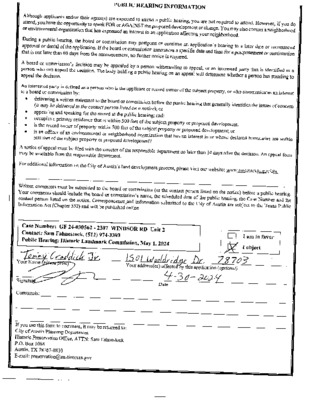
Backup
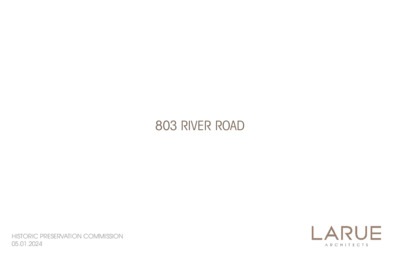
803 RIVER ROAD HISTORIC PRESERVATION COMMISSION 05.01.2024 240’ (from road) HISTORIC PRESERVATION COMMISSION 05.01.2024 FLAT ROOF (HIP ROOF) SHADOW PATTERN 1984 HISTORIC AERIAL (PHOTO TAKEN AT APPROX. 1PM CST) HISTORIC PRESERVATION COMMISSION 05.01.2024 GABLE ROOF SHADOW PATTERN 2009 HISTORIC AERIAL (PHOTO TAKEN AT APPROX. 12PM CST) HISTORIC PRESERVATION COMMISSION 05.01.2024 HISTORIC PRESERVATION COMMISSION 05.01.2024 12 5 HISTORIC PRESERVATION COMMISSION 05.01.2024
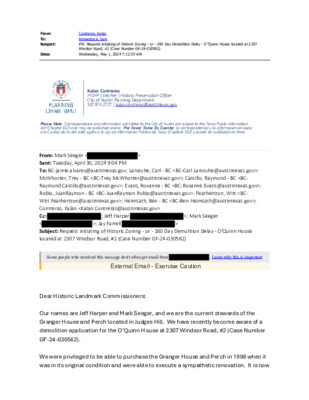
From: To: Subject: Date: Contreras, Kalan Fahnestock, Sam FW: Request initiating of Historic Zoning - or - 180 Day Demolition Delay - O"Quinn House located at 2307 Windsor Road, #2 (Case Number GF-24-030562) Wednesday, May 1, 2024 7:12:07 AM Kalan Contreras MSHP | she/her | Historic Preservation Officer City of Austin Planning Department 512.974.2727 | kalan.contreras@austintexas.gov Please Note: Correspondence and information submitted to the City of Austin are subject to the Texas Public Information Act (Chapter 552) and may be published online. Por Favor Tome En Cuenta: La correspondencia y la información enviada a la Ciudad de Austin está sujeta a la Ley de Información Pública de Texas (Capítulo 552) y puede ser publicada en línea. > From: Mark Seeger < Sent: Tuesday, April 30, 2024 9:04 PM To: BC-jamie.alvarez@austintexas.gov; Larosche, Carl - BC <BC-Carl.Larosche@austintexas.gov>; McWhorter, Trey - BC <BC-Trey.McWhorter@austintexas.gov>; Castillo, Raymond - BC <BC- Raymond.Castillo@austintexas.gov>; Evans, Roxanne - BC <BC-Roxanne.Evans@austintexas.gov>; Rubio, JuanRaymon - BC <BC-JuanRaymon.Rubio@austintexas.gov>; Featherston, Witt <BC- Witt.Featherston@austintexas.gov>; Heimsath, Ben - BC <BC-Ben.Heimsath@austintexas.gov>; Contreras, Kalan <Kalan.Contreras@austintexas.gov> Cc: < Subject: Request initiating of Historic Zoning - or - 180 Day Demolition Delay - O'Quinn House located at 2307 Windsor Road, #2 (Case Number GF-24-030562) >; Mark Seeger >; Jay Farrell ; Jeff Harper > Some people who received this message don't often get email from . Learn why this is important External Email - Exercise Caution Dear Historic Landmark Commissioners: Our names are Jeff Harper and Mark Seeger, and we are the current stewards of the Granger House and Perch located in Judges Hill. We have recently become aware of a demolition application for the O’Quinn House at 2307 Windsor Road, #2 (Case Number GF-24-030562). We were privileged to be able to purchase the Granger House and Perch in 1998 when it was in its original condition and were able to execute a sympathetic renovation. It is now a City of Austin, State of Texas and National Landmark that has been shared with the community numerous times over the past 26 years (tours, events, conferences). We respectfully request that the Historic Landmark Commission facilitate a similar fate for the O’Quinn House, also designed by Architects Fehr and Granger, by initiating historic zoning or invoking a 180 day demolition delay to allow further research on the property. We believe the O’Quinn House to be of great value to the historic fabric of our community, and that demolition would not serve …
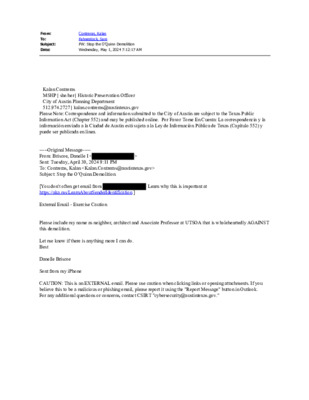
From: To: Subject: Date: Contreras, Kalan Fahnestock, Sam FW: Stop the O’Quinn Demolition Wednesday, May 1, 2024 7:12:17 AM Kalan Contreras MSHP | she/her | Historic Preservation Officer City of Austin Planning Department 512.974.2727 | kalan.contreras@austintexas.gov Please Note: Correspondence and information submitted to the City of Austin are subject to the Texas Public Information Act (Chapter 552) and may be published online. Por Favor Tome En Cuenta: La correspondencia y la información enviada a la Ciudad de Austin está sujeta a la Ley de Información Pública de Texas (Capítulo 552) y puede ser publicada en línea. -----Original Message----- From: Briscoe, Danelle I < Sent: Tuesday, April 30, 2024 9:11 PM To: Contreras, Kalan <Kalan.Contreras@austintexas.gov> Subject: Stop the O’Quinn Demolition > [You don't often get email from https://aka.ms/LearnAboutSenderIdentification ] Learn why this is important at External Email - Exercise Caution Please include my name as neighbor, architect and Associate Professor at UTSOA that is wholeheartedly AGAINST this demolition. Let me know if there is anything more I can do. Best Danelle Briscoe Sent from my iPhone CAUTION: This is an EXTERNAL email. Please use caution when clicking links or opening attachments. If you believe this to be a malicious or phishing email, please report it using the "Report Message" button in Outlook. For any additional questions or concerns, contact CSIRT "cybersecurity@austintexas.gov."
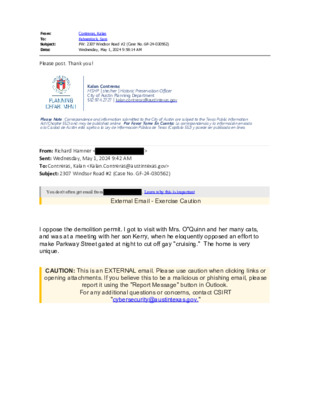
From: To: Subject: Date: Contreras, Kalan Fahnestock, Sam FW: 2307 Windsor Road #2 (Case No. GF-24-030562) Wednesday, May 1, 2024 9:58:14 AM Please post. Thank you! Kalan Contreras MSHP | she/her | Historic Preservation Officer City of Austin Planning Department 512.974.2727 | kalan.contreras@austintexas.gov Please Note: Correspondence and information submitted to the City of Austin are subject to the Texas Public Information Act (Chapter 552) and may be published online. Por Favor Tome En Cuenta: La correspondencia y la información enviada a la Ciudad de Austin está sujeta a la Ley de Información Pública de Texas (Capítulo 552) y puede ser publicada en línea. From: Richard Hamner < Sent: Wednesday, May 1, 2024 9:42 AM To: Contreras, Kalan <Kalan.Contreras@austintexas.gov> Subject: 2307 Windsor Road #2 (Case No. GF-24-030562) > You don't often get email from . Learn why this is important External Email - Exercise Caution I oppose the demolition permit. I got to visit with Mrs. O"Quinn and her many cats, and was at a meeting with her son Kerry, when he eloquently opposed an effort to make Parkway Street gated at night to cut off gay "cruising." The home is very unique. CAUTION: This is an EXTERNAL email. Please use caution when clicking links or opening attachments. If you believe this to be a malicious or phishing email, please report it using the "Report Message" button in Outlook. For any additional questions or concerns, contact CSIRT "cybersecurity@austintexas.gov."
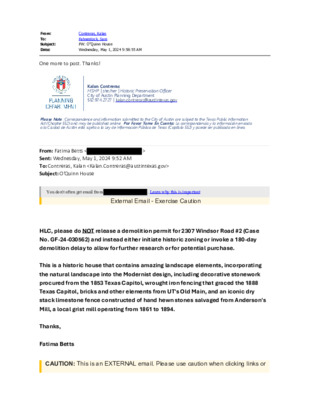
From: To: Subject: Date: Contreras, Kalan Fahnestock, Sam FW: O"Quinn House Wednesday, May 1, 2024 9:58:55 AM One more to post. Thanks! Kalan Contreras MSHP | she/her | Historic Preservation Officer City of Austin Planning Department 512.974.2727 | kalan.contreras@austintexas.gov Please Note: Correspondence and information submitted to the City of Austin are subject to the Texas Public Information Act (Chapter 552) and may be published online. Por Favor Tome En Cuenta: La correspondencia y la información enviada a la Ciudad de Austin está sujeta a la Ley de Información Pública de Texas (Capítulo 552) y puede ser publicada en línea. From: Fatima Betts < Sent: Wednesday, May 1, 2024 9:52 AM To: Contreras, Kalan <Kalan.Contreras@austintexas.gov> Subject: O'Quinn House > You don't often get email from . Learn why this is important External Email - Exercise Caution HLC, please do NOT release a demolition permit for 2307 Windsor Road #2 (Case No. GF-24-030562) and instead either initiate historic zoning or invoke a 180-day demolition delay to allow for further research or for potential purchase. This is a historic house that contains amazing landscape elements, incorporating the natural landscape into the Modernist design, including decorative stonework procured from the 1853 Texas Capitol, wrought iron fencing that graced the 1888 Texas Capitol, bricks and other elements from UT's Old Main, and an iconic dry stack limestone fence constructed of hand hewn stones salvaged from Anderson's Mill, a local grist mill operating from 1861 to 1894. Thanks, Fatima Betts CAUTION: This is an EXTERNAL email. Please use caution when clicking links or opening attachments. If you believe this to be a malicious or phishing email, please report it using the "Report Message" button in Outlook. For any additional questions or concerns, contact CSIRT "cybersecurity@austintexas.gov."
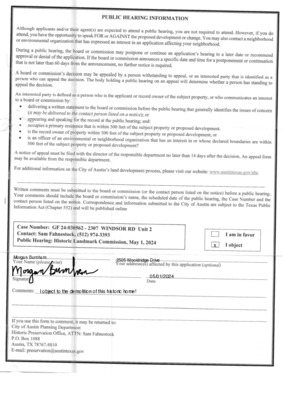
Backup
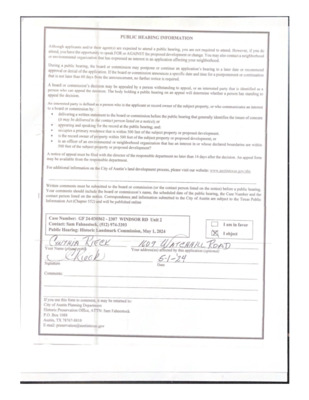
Backup
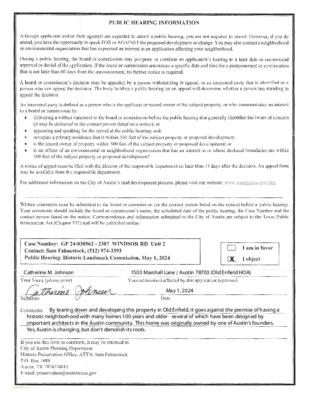
Catherine M. Johnson 1503 Marshall Lane / Austin 78703 (Old Enfield HOA) x May 1, 2024 By tearing down and developing this property in Old Enfield, it goes against the premise of having a historic neighborhood with many homes 100 years and older - several of which have been designed by important architects in the Austin community. This home was originally owned by one of Austin’s founders. Yes, Austin is changing, but don’t demolish its roots.